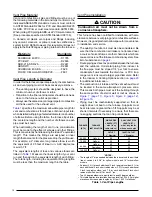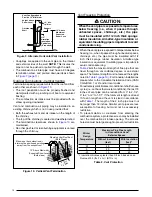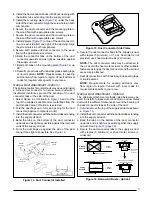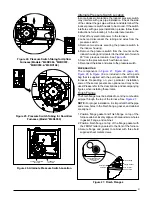
12
Table 2
Table 2.
Vent Protection
Winter
Design
Temperature
Maximum Flue Pipe Length
in Unconditioned and
Exterior Spaces
Without Insulation
(feet)
With Insulation
(feet)*
20
45
70
0
20
70
-20
10
60
* = Insulation thickness greater than 3/8 inch, based on an
R value of 3.5 (ft x F x hr) / (BTU x in.)
• Couplings are applied to the vent pipe on the interior
and exterior sides of the wall. NOTE: This insures the
pipe can not be pushed or pulled through the wall.
• The combustion air inlet pipe must have a 90 degree
termination elbow, and pointed downwards as shown
in
.
Outdoor Terminations - Vertical Venting
Termination spacing requirements from the roof and from
each other are shown in
• The roof penetration must be properly flashed and
waterproofed with a plumbing roof boot or equivalent
flashing.
• The combustion air intake must be provided with an
elbow opening downward.
Vent and combustion air piping may be installed in an
existing chimney which is not in use provided that:
• Both the exhaust vent and air intake run the length of
the chimney.
• The top of the chimney is sealed and weatherproofed.
• The termination clearances shown in
maintained.
• No other gas fired or fuel-burning equipment is vented
through the chimney.
Figure 9
Outside
Wall
Support
Vent Configuration to
Provide 12" Minimum
height above
Snow Level.
1/2"
Armaflex
Insulation or
Equivalent
(if required)
12" Above
Maximum
Expected
Snow Level
12" Min.
19" Max.
Figure 9. Alternate Horizontal Vent Installation
Vent Freezing Protection
CAUTION:
When the vent pipe is exposed to temperatures
below freezing (i.e., when it passes through
unheated spaces, chimneys, etc.) the pipe
must be insulated with 1/2 inch thick sponge
rubber insulation, Armaflex-type insulation or
equivalent. Insulating pipe is important to avoid
condensate icing.
• When the vent pipe is exposed to temperatures below
freezing (i.e., when it passes through unheated spaces,
chimneys, etc.) the pipe must be insulated with 1/2
inch thick sponge rubber insulation, Armaflex-type
insulation or equivalent. Insulating pipe is important to
avoid condensate icing.
•
lists the maximum length of flue pipe that can
travel through an unconditioned space or an exterior
space. The total vent length must not exceed the lengths
noted in
. For Canadian installations
please refer to the Canadian Installation Code (CAN/
CGA-B149.1 or 2) and/or local codes.
• For extremely cold climates or conditions of short furnace
cycles (i.e. set back thermostat conditions), the last 18
inches of vent pipe can be reduced from 3” to 2-1/2”,
3” to 2” or 2” to 1-1/1” if the total vent length is at least
15 feet in length and the vent is sized in accordance
with
. The length of the 2 inch pipe must not
be longer than 18 inches. Smaller vent pipes are less
susceptible to freezing, but must not be excessively
restrictive.
• To prevent debris or creatures from entering the
combustion system, a protective screen may be installed
over the combustion air intake opening. The screens
hole size must be large enough to prevent air restriction
Figure 10
Figure 10.
Vertical Vent Termination
Comb
ustion Air
Exhaust
V
ent
12” Above Maximum
Expected Snow Level
(Both pipes)
Elbows on the combustion air
inlet must be positioned pointing
away from the exhaust vent.
8" Min.
36" Max.
Plumbing Vent Roof Boot
(Both Pipes)
Содержание M4RC-072D-35C
Страница 47: ...47...



























